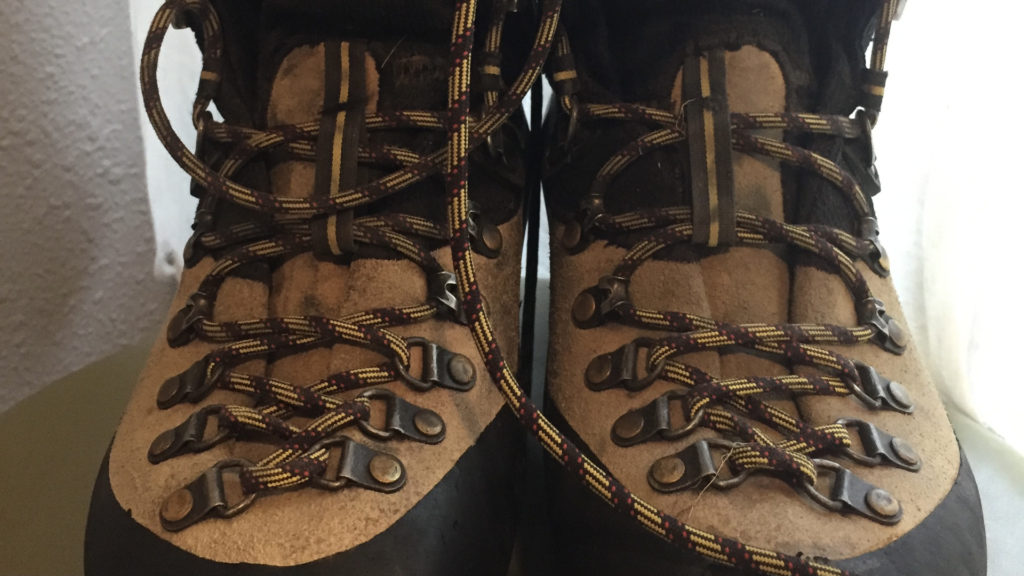Glaciers, anyone? Snow? Crampons? These are the boots that you would take up Rainier and Aconcagua and Denali. They aren’t going to be bunny-slipper comfortable no matter what, just because of the rigid sole—a sole so inflexible that they have made more than one person do a quick Frankenstein impression on the side of a mountain (it never gets old)—so don’t expect the same sweet vibe as your day-hiking boots. But you’ll get used to the stiffness quickly and grow to appreciate how incredibly insulated this type of boot is, how steady you’ll feel lashing your crampons to them and inching up slopes of dizzying angles, and how many years they will last. When they say “bring out the big guns,” this is what they have in mind.
For a lot of folks, getting your first mountaineering boot is one of those moments where you feel yourself level up, leaving “regular hiking” behind and journeying into a more technical, higher risk, advanced form of hiking, where you could safely use the words “mountain climbing.” Mountaineering boots mean there will crampons, snow, chilly temps, likely an ice axe and possibly a harness and rope.
And here is where you go for safety and functionality over comfort. I mean of course you want them comfortable, but this is a rigid-soled boot that will make you walk as if you’re in ski boots and run in a remarkably ungraceful way. But when you need to slam your toes into icy snow to kick steps, you will be thankful for its well-insulated, very protective toebox and the way the stiff sole holds your crampons tight and gives you incredible stability. Some of what puts these in a whole other genre are:
Features
Insulated/Multilayered Construction:
- Completely rigid sole
- Groove for clip-in style crampons
- Multilayered construction (rather than having inner and outer boots).
- Provide a super-comfortable fit once they’re fully broken in
- Waterproof (but needs periodic treatment to remain waterproof)
- Rugged leather (or synthetic material) resists abrasion
- Moderately warm (a few ultra warm models actually have an insulated inner boot)
- Lighter than plastic boots and more suited to long approach hikes
- Average 3-4 pounds per pair
Plastic Construction (hard-shell plastic on the outside with a soft inner boot):
- Not widely sold, but a staple of rental shops because they’re durable and fit OK for one-time users
- Shell stands up to ice and abrasion well
- Completely rigid sole
- Groove for clip-in style crampons
- Waterproof shells slough off slushy snow
- Ample warmth for cold conditions
- Soft inner boot is moderately comfortable without requiring a break-in period
- Used exclusively for mountaineering; not comfortable for long approach hikes
- Average 4-6 pounds per pair
Uses
- Climbs for which crampons are necessary
- Climbs on snow, ice, glaciers
Best Mountaineering Boots For Women
- La Sportiva Nepal Cube GTX
- La Sportiva Baruntse
- Lowa Alpine Expert GTX
- Scarpa Mont Blanc Pro GTX
- Mammut Taiss Light Mid
Brace yourself for the sticker shock; mountaineering boots are spendy (in the $300-$600 range). But they’ll also be with you for roughly ever because you’re only going to wear them a handful of times a year and they’re built like tanks. Brace yourself also for the feelings of excitement, empowerment, and freedom as you set your sights on bigger, higher, more complex summits, the likes of which you’d previously only dreamed of.

Wendy Harrington is a California native who has lived in a small town at the foothills of the Cascade Mountains in Washington state since 2001. Her love of trail running and peakbagging has led her to summit all five Washington volcanoes, climb to the high points of three states, and put nearly a thousand miles a year on her boots. Her loves include ridgelines, saddles, granite, one-day pushes on big mountains, anything volcanic, long solo days, and objectives that push limits and test endurance.

